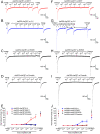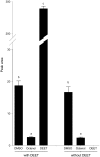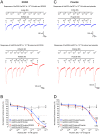Insect repellents: modulators of mosquito odorant receptor activity
- PMID: 20725637
- PMCID: PMC2920324
- DOI: 10.1371/journal.pone.0012138
Insect repellents: modulators of mosquito odorant receptor activity
Abstract
Background: DEET, 2-undecanone (2-U), IR3535 and Picaridin are widely used as insect repellents to prevent interactions between humans and many arthropods including mosquitoes. Their molecular action has only recently been studied, yielding seemingly contradictory theories including odorant-dependent inhibitory and odorant-independent excitatory activities on insect olfactory sensory neurons (OSNs) and odorant receptor proteins (ORs).
Methodology/principal findings: Here we characterize the action of these repellents on two Aedes aegypti ORs, AaOR2 and AaOR8, individually co-expressed with the common co-receptor AaOR7 in Xenopus oocytes; these ORs are respectively activated by the odors indole (AaOR2) and (R)-(-)-1-octen3-ol (AaOR8), odorants used to locate oviposition sites and host animals. In the absence of odorants, DEET activates AaOR2 but not AaOR8, while 2-U activates AaOR8 but not AaOR2; IR3535 and Picaridin do not activate these ORs. In the presence of odors, DEET strongly inhibits AaOR8 but not AaOR2, while 2-U strongly inhibits AaOR2 but not AaOR8; IR3535 and Picaridin strongly inhibit both ORs.
Conclusions/significance: These data demonstrate that repellents can act as olfactory agonists or antagonists, thus modulating OR activity, bringing concordance to conflicting models.
Conflict of interest statement
Figures





Similar articles
-
Multiple activities of insect repellents on odorant receptors in mosquitoes.Med Vet Entomol. 2011 Dec;25(4):436-44. doi: 10.1111/j.1365-2915.2011.00949.x. Epub 2011 Mar 14. Med Vet Entomol. 2011. PMID: 21395633
-
Odorant receptor modulation: ternary paradigm for mode of action of insect repellents.Neuropharmacology. 2012 Apr;62(5-6):2086-95. doi: 10.1016/j.neuropharm.2012.01.004. Epub 2012 Jan 18. Neuropharmacology. 2012. PMID: 22269900
-
The ovipositor cue indole inhibits animal host attraction in Aedes aegypti (Diptera: Culicidae) mosquitoes.Parasit Vectors. 2022 Nov 12;15(1):422. doi: 10.1186/s13071-022-05545-8. Parasit Vectors. 2022. PMID: 36369215 Free PMC article.
-
Making scents of mosquito repellents.Trends Parasitol. 2025 Apr;41(4):280-289. doi: 10.1016/j.pt.2025.02.009. Epub 2025 Mar 10. Trends Parasitol. 2025. PMID: 40068978 Review.
-
The mysterious multi-modal repellency of DEET.Fly (Austin). 2015;9(1):45-51. doi: 10.1080/19336934.2015.1079360. Fly (Austin). 2015. PMID: 26252744 Free PMC article. Review.
Cited by
-
Molecular and functional characterization of odorant-binding protein genes in an invasive vector mosquito, Aedes albopictus.PLoS One. 2013 Jul 23;8(7):e68836. doi: 10.1371/journal.pone.0068836. Print 2013. PLoS One. 2013. PMID: 23935894 Free PMC article.
-
Prior contact with permethrin decreases its irritancy at the following exposure among a pyrethroid-resistant malaria vector Anopheles gambiae.Sci Rep. 2019 Jun 3;9(1):8177. doi: 10.1038/s41598-019-44633-1. Sci Rep. 2019. PMID: 31160750 Free PMC article.
-
Insect repellents mediate species-specific olfactory behaviours in mosquitoes.Malar J. 2020 Mar 30;19(1):127. doi: 10.1186/s12936-020-03206-8. Malar J. 2020. PMID: 32228701 Free PMC article.
-
Isolation and identification of mosquito biting deterrents from the North American mosquito repelling folk remedy plant, Matricaria discoidea DC.PLoS One. 2018 Oct 31;13(10):e0206594. doi: 10.1371/journal.pone.0206594. eCollection 2018. PLoS One. 2018. PMID: 30379955 Free PMC article.
-
The impact of transfluthrin on the spatial repellency of the primary malaria mosquito vectors in Vietnam: Anopheles dirus and Anopheles minimus.Malar J. 2020 Jan 6;19(1):9. doi: 10.1186/s12936-019-3092-4. Malar J. 2020. PMID: 31906969 Free PMC article.
References
-
- McCabe ET, Barthel WF, Gertler SI, Hall SA. Insect repellents. III. N,N-Diethylamides. J Org Chem. 1954;19:493–498.
-
- Ditzen M, Pellegrino M, Vosshall LB. Insect odorant receptors are molecular targets of the insect repellent DEET. Science. 2008;319:1838–1842. - PubMed
Publication types
MeSH terms
Substances
LinkOut - more resources
Full Text Sources
Other Literature Sources

